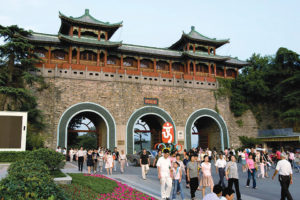The Taiping Heavenly Kingdom History Museum owes its 1958 establishment to Chinese Communist Chairman Mao Zedong, who claimed the 1850–64 Taiping Rebellion as an early communist revolution. Mao further underscored the museum’s political and cultural significance by ordering it sited in Nanjing, a city besieged both during the rebellion and in December 1937 by invading Japanese forces, who committed notorious atrocities.

Largely unknown to Americans, as it took place before and during the U.S. Civil War, the far bloodier Taiping Rebellion took the lives of perhaps as many as 30 million Chinese. The conflict had its roots in 1836 when a peasant named Hong Xiuquan traveled to Canton to take the civil service exams. After repeatedly failing the tests, Hong reportedly suffered a breakdown and in his neurotic state blended mystical dreams and a distorted interpretation of missionary tracts into a belief he was God’s Chinese son, a literal brother to Jesus Christ, sent to reform China. The disturbed man appealed to fellow peasants to join his cult, overthrow the corrupt Qing dynasty and replace it with the Taiping Tianguo (Heavenly Kingdom of Great Peace). The movement grew quickly, soon drawing a half-million fighting men and an equal number of camp followers. The resulting rebellion spawned hundreds of battles around China, but the decisive clash centered on the almost continuous 1853–64 siege of the Taiping capital at Nanjing.
The massive Taiping rebel force destroyed all in its path while advancing down the Yangtze River toward Nanjing in 1853, in the process rolling back a far weaker Qing army. In March the rebels reached Nanjing and began digging siege lines and tunnels in an attempt to breach the city’s defensive walls. Qing officials thought Nanjing was impregnable, as 40-foot-high stone walls some 25 miles in circumference ringed the city, garrisoned by some 55,000 defenders. Though more than a quarter-million civilians had fled the city, tens of thousands of men, women and children remained. Their complacency proved fatal.
After completing their tunnels, the besiegers packed the galleries with explosives and demolished broad sections of the city walls. The Taiping rebels then surged into Nanjing to slaughter both Qing soldiers and civilians. They killed the entire Qing garrison and some 30,000 civilians, while losing just 10,000 men.
Additional Qing armies soon marched on Nanjing. Unable to retake the city, they built fortified camps outside its walls and besieged the rebels for more than a decade. In 1861 the Qing forces launched a campaign of genocide against the villages and cities supporting the Taiping rebels, and by 1863 the imperial troops had taken a strategic castle from which they bombarded the city with artillery and rockets. The next year Qing sappers began digging their own assault tunnels, and on July 19, 1864, in a series of massive explosions, they collapsed a 70-yard stretch of Nanjing’s walls. The tables turned, the Qing army rampaged through the city, cutting down rebels and complicit civilians alike. It marked the effective end of the rebellion, though holdouts roamed the province through 1871.
Housed in the Zhan Yuan Garden and Palace—home to Ming and Qing emperors, as well as Hong Xiuquan himself—the Taiping Heavenly Kingdom History Museum relates the story of the rebellion and its impact on Chinese culture. Its collection includes items from the conflict, as well as communist propaganda linking that long-ago event with China’s civil war in the 20th century. The museum also displays a variety of ancient and modern weapons, while visitors can explore walls and ruins dating from the epic siege.
First published in Military History Magazine’s May 2017 issue.

